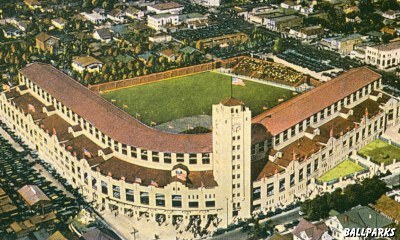Wrigley Field
Los Angeles, California
Tenant: Los Angeles Angels (AL)
Opened: September 29, 1925
First Angels game: April 27, 1961
Last Angels game: October 1, 1961
Demolished: 1966
Capacity: 22,000 (1925), 20,457 (1961)
Surface: Grass
Los Angeles Angels tickets:
Location: In south-central Los Angeles at the intersection of 42nd Place and Avalon Boulevard. First base (S), 42nd Place; right field (E), Avalon Boulevard; left field (N), 41st Place; third base (W), San Pedro Street.
Dimensions: Left field 340 ft..; power alleys: 345 ft.; center field: 412 ft.; right field: 338.5 ft.; backstop: 56 ft.
Fences: Left field to center field: 14.5 ft.; center field to right field: 9 ft. (6 ft. wire above 3 ft. concrete)
Facts:
- Home to the Pacific Coast League's Los Angeles Angels from 1925 to 1957 and Hollywood Stars from 1926 to 1935, plus 1938.
- The park was designed to be like Wrigley Field in Chicago and was named for William Wrigley, the chewing-gum magnate who owned both the Cubs and the Angels (Pacific Coast League). Wrigley Field in Los Angeles got its name on September 29, 1925, where as Wrigley Field wasn't so named until 1926.
- Replaced the 15,000 seat Washington Park, which was used from 1903 until 1925.
- Outfield fences angled slightly toward home plate as they moved away from the foul lines, which made for short power alleys and more home runs.
- It Happens Every Spring with Ray Milland, television's "Home Run Derby" and an episode of "The Munsters" were filmed here. Scenes from the movie version of Damn Yankees were also filmed here.
- In February 1957, Chicago Cubs owner Phil Wrigley sold the Angels and their ballpark to Walter O'Malley, the Brooklyn Dodgers' owner, for $3,000,000 and the rights to the Dodgers' Texas League franchise in Fort Worth. This secured territorial rights to Los Angeles for the Dodgers, enabling their move to the city later that year.
- An architect's 1957 drawing envisioned enclosing the field for use by the Dodgers, with double-decked stands in left and right, and center field bleachers, very much like the Polo Grounds.
- In the only season that Major League Baseball was played at Wrigley Field, 248 home runs were hit there, more than in any other ballpark in Major League history during a single season.
- Home to PCL greats like Jigger Statz and Steve Bilko. Others who played there include Buzz Arlett, Ike Boone, Bunny Brief, Ollie Carnegie, Ox Eckhardt, Joe Hauser, Smead Jolley, Frankie Kelleher, Rocky Nelson and Lou Novikoff.
- Site is now occupied by a public park and recreation center, a community mental health center, and a senior citizens' center.
Recommended Reading (bibliography):
- Take Me Out to the Ballpark: An Illustrated Tour of Baseball Parks Past and Present by Josh Leventhal and Jessica Macmurray.
- The Ballpark Book: A Journey Through the Fields of Baseball Magic (Revised Edition) by Ron Smith and Kevin Belford.
- City Baseball Magic: Plain Talk and Uncommon Sense about Cities and Baseball Parks by Philip Bess.
- Diamonds: The Evolution of the Ballpark by Michael Gershman.
- Green Cathedrals: The Ultimate Celebration of All 273 Major League and Negro League Ballparks by Philip J. Lowry.
- Lost Ballparks: A Celebration of Baseball's Legendary Fields by Lawrence S. Ritter.
- Roadside Baseball: A Guide to Baseball Shrines Across America by Chris Epting.
- The Story of America's Classic Ballparks (VHS).
Help us provide a better web site by completing our feedback form
Aerial view of Wrigley Field in Los Angeles courtesy of the Franklin Digital Collection.
Updated March 2005
Tickets to Los Angeles Angels, Los Angeles Dodgers, NCAA Basketball Tournament, College Football Bowl, NCAA Football, Paul McCartney and Wicked Hollywood provided by Ticket Triangle.
BALLPARKS © 1996-2014 by Munsey & Suppes.
|



